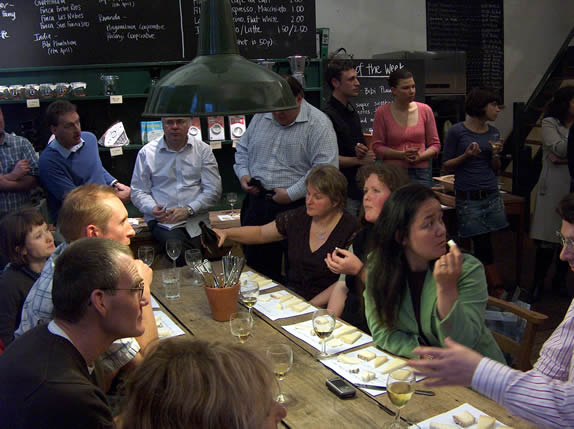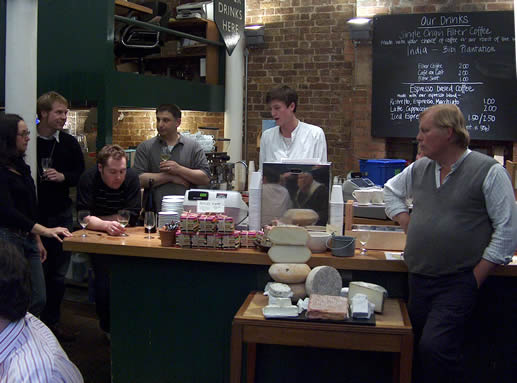|
A
workshop on sheep's cheese

The
cheesemakers sitting around the central table
Five years ago I didnít eat cheese. Now I love it.
Itís strange how tastes can change, but it seems that tastes
that are quite hard to acquire are often the most enduring ones.
So I was delighted to be invited to a sheepís cheese
workshop, held by Nealís Yard Dairy at the Monmouth Coffee Shop
in Borough Market. The event brought together several of the
UKís leading proponents of eweís milk cheese to discuss their
produce with an attentive audience made up largely of Nealís
Yard employees.
It was a remarkable evening: while Iím just an
interested learner when it comes to cheese, the discussions and
commentary gave me an insight into issues involved in making
serious cheese. This was a pretty hardcore cheese-nut evening.
Many of the issues under discussion were reassuringly scientific
in nature, though Ė familiar territory for me Ė because cheese
making is essentially practical microbiology.
The evening was compered (in a very loose way) by
Randolph Hodgson, who stimulated the bulk of the discussion by
asking appropriate questions. For those who donít know him,
heís the dude behind Nealís Yard. Jancis Robinson says that
Randolph Ďhas done more in my opinion for the quality and integrity
of British food than all the chefs on television and those who
have appeared in the honours listsí.
We had two wines with the cheese, which were selected
by Randolphís son, Raef, who is currently working in the wine
trade at The Winery in London. First, a German Riesling that was
crisp and fresh, with a nice texture. It was dry and quite broad
with melon and lemony notes. Then we had a white Burgundy (a
Bourgogne Blanc 2004) that was smooth, rich, balanced with nothing
sticking out and a nice texture. Lemony and nutty. Both worked
well but not spectacularly with the cheeses. I apologise for not
having more specific details of the wines Ė my attention was on
the cheese for this occasion.

Randolph
Hodgson (far right), next to his son Raef and a pile of cheeses
Frances Percival, a food writer with an interest in
wine and cheese matching, points out that salt and rinds are a
challenge for wine matching. Rind fights with any wine you put
with it. The only real option is to blast past it with something
seriously sweet. Tannic reds react negatively with cheeses and end
up tasting metallic and thin. Randolph suggests that wine and
cheese donít really go very well together, but suggests out that
beer is great. [Having said this, the wines disappear pretty
quickly, suggesting that they arenít an awful match.]
Here, Iím reproducing my notes from the evening. I
realize that this is a bit geeky, but I wanted to capture some of
the spirit of the evening, which was a group of passionate
producers with a dedication to making authentic, characterful
cheeses, and who were happy to share their knowledge with an
attentive audience. This sort of open-minded pursuit of excellence
is, to me, very exciting.
Wigmore
Anne and Wendy Wigmore make two cheeses: Spenwood and
Wigmore. The first is hard, the second semi-soft. Theyíve been
going for 20 years and buy in all their milk. They also make
cowís milk cheese (Waterloo).
The Wigmore we
try is soft and smooth with nice tangy acidity. Itís quite broad
with a lovely smooth texture and a bit of smokiness. Good rind and
a grassy, herby finish.
Anne says this is a nice cheese, and that it has
improved since they changed the size: now it matures more evenly.
With larger cheeses they were getting a more acidic centre, and
this acid was developing because the brine (used to salt the
cheese, controlling microbial growth) didnít get through to the
centre.
Might the cheese improve? The risk is that the rind
might dry out. They use a penicillium mould for a rind that
doesnít get too thick. Itís a washed curd cheese, which is a
way of reducing the acidity in the vat.
Spenwood
is
semi-hard with lovely warm, rich nutty flavours. Quite sweet with
crumbly but smooth texture. Nice balance here: itís almost a bit
cakey. Delicious.
Anne says that this is a bit too young. She thinks it
might be Januaryís cheese, because they had difficulty getting
hold of sheepís milk in November and December, so everything
made in these months became Wigmore. She thinks that a nutty
flavour will come through after six months. Randolph says itís a
shame to cut it early, but itís still a lovely cheese.
Freeze dried starter culture is used here. One of the
problems in dairies is the presence of bacteriophages (specialized
viruses that attack bacteria) that can knock out certain strains
of bacteria. As a result, the sachets of freeze-dried bacteria
typically have a mix of strains. Itís necessary to do TA
(titratable acidity) titrations to get a consistent acid increase
in the cheese. Some people use pH meters, but these have been
found to be variable in practice Ė many of the producers
describe them as useless because thereís too much variation in
the readings.
Flower
Marie
Kevin and Alison Blunt make Golden Crust (from their
own goatís milk) and Flower Marie from bought-in sheepís milk,
which has been made since 1992.
The Flower Marie we try is soft, rich, fat and tangy.
Itís quite mellow: smooth and broad with some nuttiness and some
tang.
Kevin thinks it is not breaking down under the rind
enough Ė itís perhaps a bit too salty for him. This cheese is
made with either fresh or frozen milk that is allowed to coagulate
for 14 h, ready for ladling the next morning. ĎI like the
textureí, he says. ĎThis will break down a bit more as it
matures. I donít like them to get really gooey as if it breaks
down under the rind too much you get soapy flavoursí.
Randolph asked whether Kevin had considered using dry
salting as an alternative to brine, but Kevin replied that he
hasnít with sheepís cheeseí. In response to a question, most
of the cheesemakers present said that they brined, but some also
did dry salting.
Little
Riding
Dave Bartlett is from Wooton Organic and makes Little
Riding, along with James Bartlett, Tamsin Rampling and Hannah
Burr. They have 220 ewes, of which they milk 100.
Itís soft, fat and a bit grainy with some salt adding
balance. Broad and quite rich. The rind isnít too thick.
ĎWe get some grey mould on the rind, but we would
like to get on top of thisí, says Dave. They are trying to get
the environment right for the rind to grow well, and recently
changed the recipe. They are using Geotrichum
rather than Penicillium,
a mould that doesnít give thick white rinds. There is some
discussion about whether thick white rinds are an English style,
and the general conclusion is that they arenít. Thereís also
some discussion about humidity for rind growth, along with some
fairly technical talk about rinds in general.
Berkswell
Linda Dutch makes Berkswell cheese with the Fletcher
family from 500 ewes that they milk. Itís a hand-pressed hard
cheese.
We tried two examples, both made on the same day.
Berkswell ĎCí 26.2.07. Vegetable rennet. Hard.
Nice, smooth, a bit crumbly with some tang. Quite broad textured.
Frutier, with more acid.
Berkswell ĎDí 26.2.07. Animal rennet (lamb). A bit
harder with less richness, and a smoother, firmer texture. Quite
savoury, with broad flavours. Deeper and richer.
Randolph pointed out that he can almost always taste
the difference between cheeses made with vegetable and animal
rennet. The vegetable rennet gives cheeses that are spikier,
spritzier and fruitier; the animal rennet makes smoother cheeses.
Animal rennet comes from the stomachs of young
slaughtered animals. The young females are kept, but there is no
use for the young males. The Fletchers had 250 male lambs that
they didnít need this year. Some are sold to city farms, but the
rest have to be slaughtered, and as they donít even weigh 3
kilos, there is no market for them. The dairy industry is
criticized for this, but animal welfare standards are high: unless
animals are happy they wonít milk well. As an example of the
effort required to keep your animals happy and healthy, from
December to March, they worked at least 13 hour days with just one
weekend off.
Crockhamdale
Victoria Tagg makes Crockhamdale from bought in milk, which is
based on old Wensleydale recipe. She canít find enough milk.
Itís semi-hard. Nice and tangy with a lovely grainy
texture. Dry and quite firm, with a sheepy tang that reminds me of
Manchego. Grassy and spicy, too.
Victoria says that this is young. She likes it young in
the spring and summer when it is milder and quite moist. Often it
is more crumbly than this, she adds. This one is 6Ė8 weeks old.
In the early days the cheese was quite open on the outside, so
they had to get a better press. They then ended up making 32
cheeses in different ways to find a way to prevent the cracking:
the key seemed to be the strength used putting it into the mould.
The recipe was created by James Aldrich, who was a
cheese retailer who had in a previous life been a scaffolder. He
was responsible for lots of cheese recipes, but didnít want the
drudgery of making them day in and out.
St
James
Made by Martin Gott, the St James we try is smooth, rich, intense
and salty. Itís tangy and a bit stinky. Delicious with some
pungent acidity. A rich style thatís smooth, soft and quite
striking.
Unfortunately, Martin had to kill his flock and this
cheese was made from bought-in milk. Itís the first cheese of
the season: thick and acid. The next lot is thinner and less acid.
All these cheeses are available from Nealís Yard (www.nealsyarddairy.co.uk).
Back
to top
|

